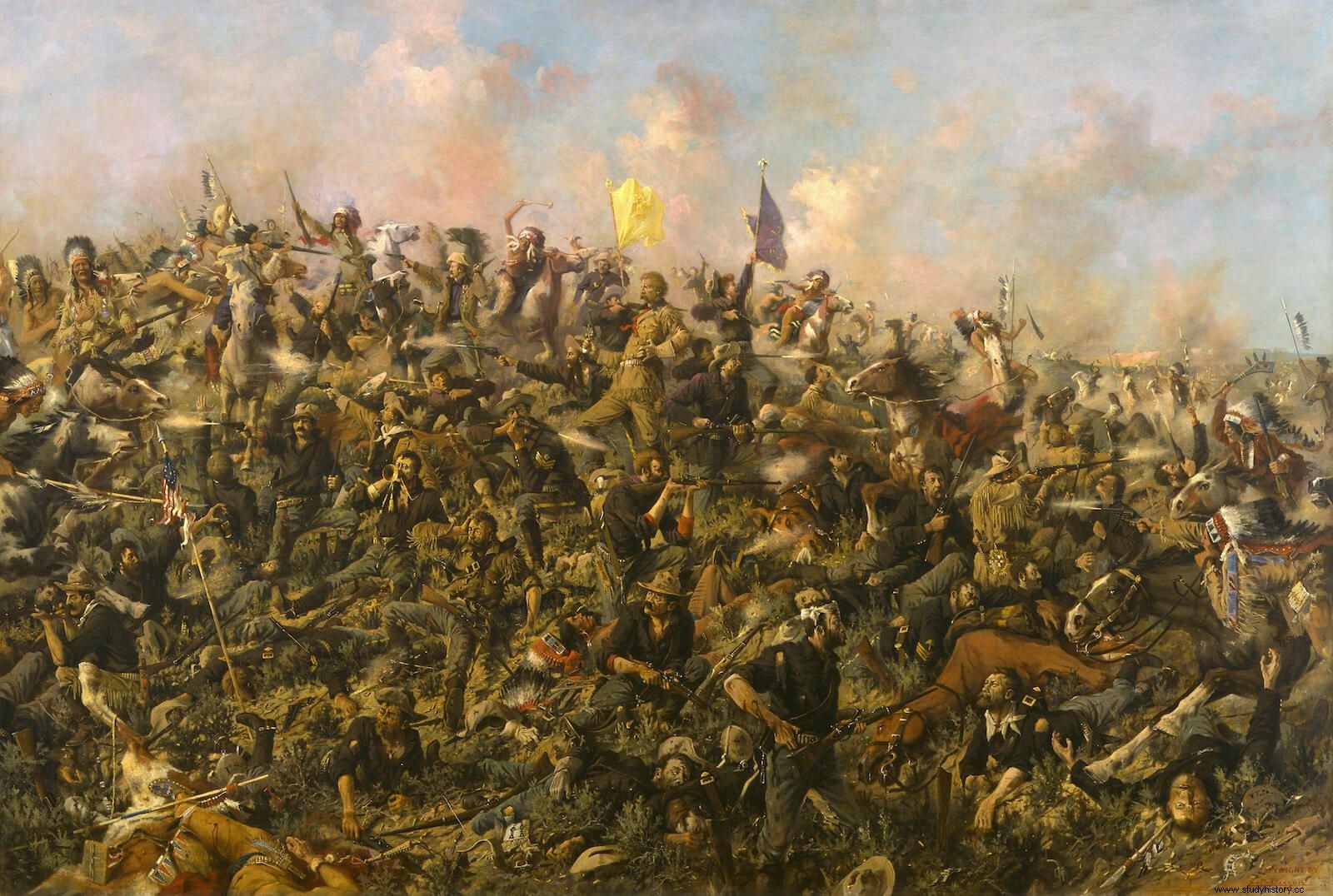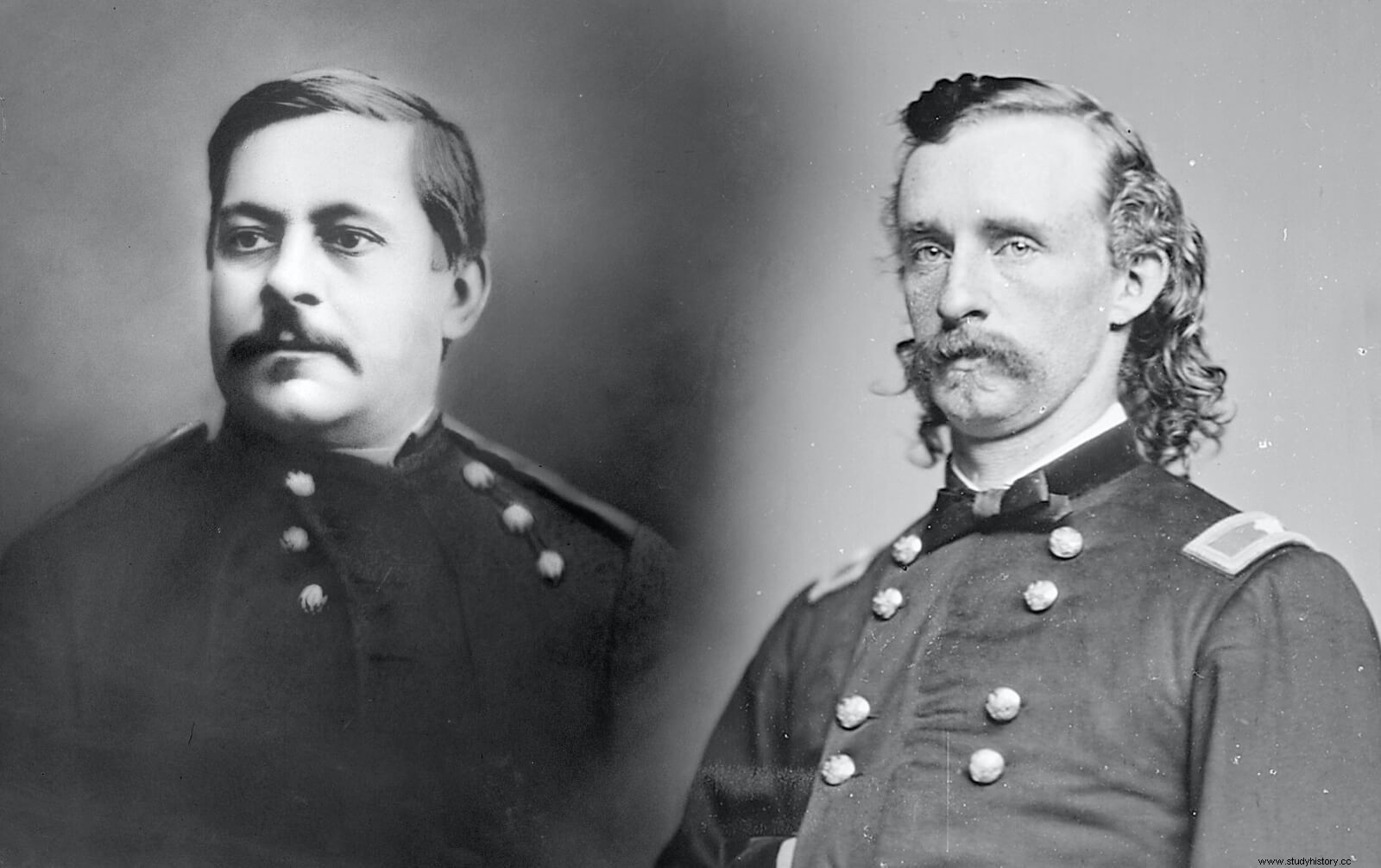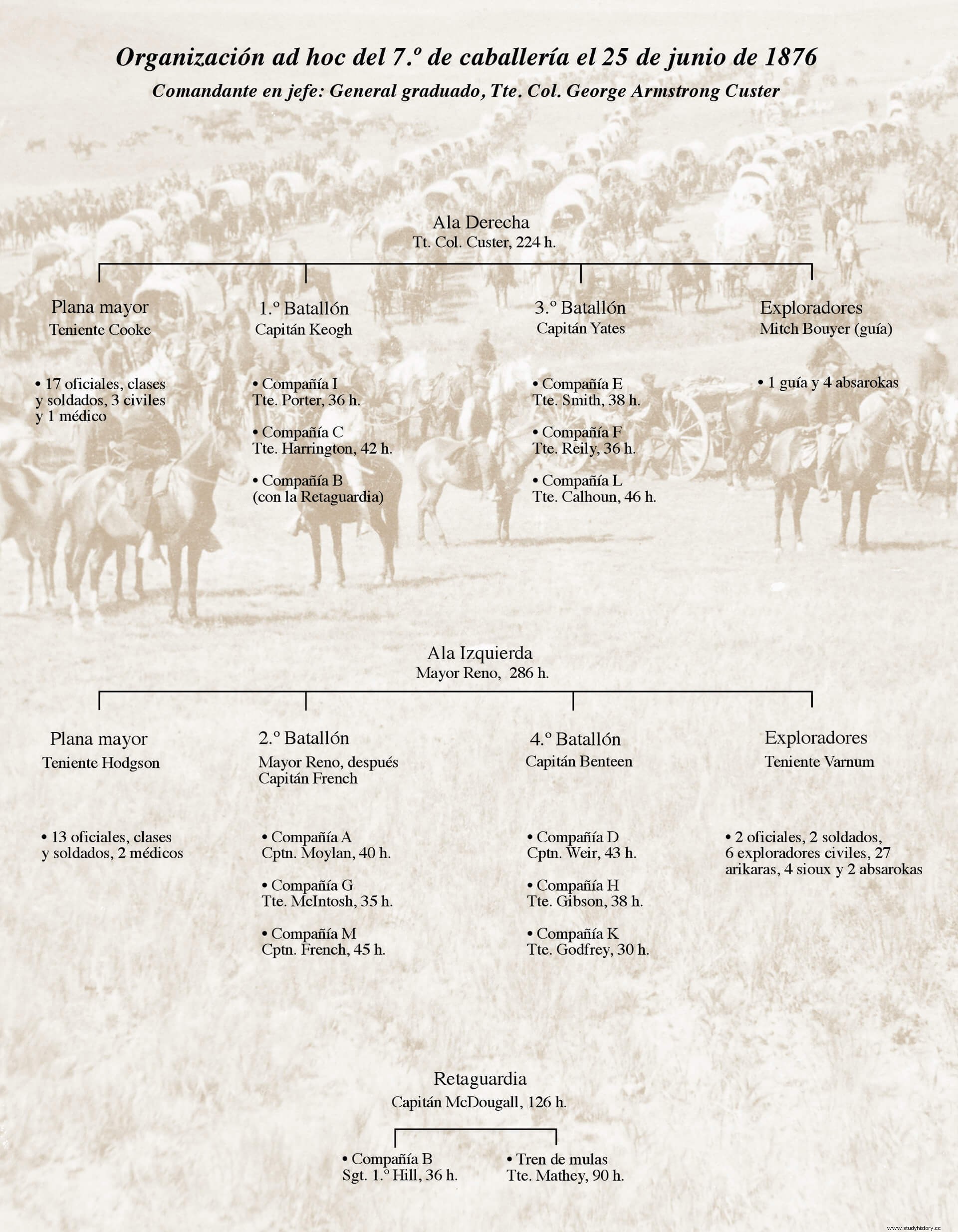
On that day, the 7th Cavalry it was not organized as it had been when it left Fort Lincoln the previous month, with four battalions of three companies spread over two wings. A few days ago, and after the relative fiasco of the expedition to the Tongue River by the left wing of the 7th under Major Reno (his counterproductive insubordination almost cost him a court martial), Custer decided to disband wings and battalions in the Regiment:For the new expedition Terry entrusted to him on June 21, each company would report directly to him until further notice.
Four days later, around 10 a.m. on June 25, Custer took advantage of the first statutory stop after leaving the divide camp to return the 7th to its organization in four battalions. According to eyewitnesses, he did it "with pencil and paper" in a ten-minute aside with the regimental adjutant, Lieutenant Cooke, who then communicated it in writing to the different company commanders. Unfortunately, Cooke's large order book was lost in the massacre , leaving an intriguing question unanswered:was it only the previous distribution of the regiment in battalions, or also its original division in wings?
Custer's death in combat left his two immediate subordinates, Major Reno (acting lieutenant colonel) and Captain Benteen ( interim major); and what suited their personal defensive strategy—and their more laudable desire to preserve the regiment's honor—was to say that Custer maintained direct command over the four battalions, and that the confused or non-existent orders under which they had to act theirs did not let them act differently.
The self-exculpatory testimony of the surviving commanders, with their implicit accusation of Custer being irresponsible and incompetent , he should be caught with tweezers. Custer's brilliant and long record as a commander of mounted troops – both in regular and irregular warfare – would be enough to call such accusations into question; but the best refutation of it seems to be found in the mere observation of the events that occurred on June 25, 1876.
Unraveling the organization of the 7th Cavalry
In his official part, written a few days after the battle, Major Reno alluded to that order "issued at Yellowstone that annulled the organization in Wings and Battalions, but Custer He informed me that he would assign commands on the fly.” And indeed he did. Everything seems to indicate that Custer, "on the fly" and hardly stopping, not only recreated his four old battalions, but de facto divided the 7th into its original Left Wing and Right Wing:the first led by himself, the second by Reno. And as much as Custer claimed to have received only the command of the 2nd battalion of the regiment, a fact that significantly silenced his entire life belies him: Custer also put under his command the staff staff who was part of the general headquarters of his Wing from the very beginning of the campaign, and which at that time consisted of an assistant lieutenant, an engineer-enabled lieutenant, two doctors with their respective assistants, a corporal, an order trumpet, five orderlies and a clerk. It was not an escort or "honor guard", but a team designed to prepare, transmit and verify the execution of the commander's orders as quickly and efficiently as possible. Also Captain Benteen, at the beginning of the campaign, had his own staff as Wing Commander; but when these were disbanded the personnel were reincorporated into his companies, never returning to his command when he assumed command of the 4th Battalion on the 25th. Obviously because, unlike Reno, he was no longer a commanding officer. Ala.
It is clear, therefore, that Reno went into action with a larger squad of 15 members including paramedics, later supplemented by an expert guide –Reynolds– and a detachment of Arikara scouts and Sioux; and that Custer, for his part, rode at the head of the Keogh and Yates battalions with a staff of 18 members, including paramedics, plus an expert guide –Bouyer– and a party of Absaroka scouts. None of the other 7th Cavalry battalion commanders – Benteen, Keogh, and Yates – were assigned any scouts, or any sanitary, or more “staff personnel” than the assistant they were entitled to because of their status as officers.

Let us now turn our attention to the flow of events :The great Indian track that the 7th Cavalry is following up Ash Creek forks into two near its confluence with the Little Bighorn, one branch continuing on the left bank and the other, more recent, on the right. Consequently Custer divides the regiment in two to follow both tracks . Each half is accompanied by a staff of similar characteristics, both complemented by medical personnel, guides and explorers. The right half, which we can call the Right Wing not only because of its location and because it follows the right bank of the river, but also because it is made up of the same battalions that made up the Right Wing since its departure from Fort Lincoln, marches in search of the enemy, interposing between it and the left half (or Left Wing, for the same reasons) a long chain of imposing cliffs and a swollen river with steep banks. It is obvious that such obstacles will make it difficult for both wings to communicate or even maintain visual contact. And those difficulties will not end with the success of the simultaneous attack devised by Custer. The defeated hostiles will have to be closely pursued to the north, pushing them towards Terry's column and preventing them from fleeing west or crossing the river and scattering to the east. Thus, for miles and miles, both wings must operate separated by the river, ready to promptly abort any attempt by the fugitives to turn left or right. It is obvious, therefore, the reason that would have moved Custer to reconstitute the wings of the 7th:the particular nature of the mission entrusted by Terry, which made it inevitable to maneuver with two operational commands separated by adverse terrain, but capable of act quickly and independently in response to what the enemy tried.
This well-founded hypothesis is objected to by some scholars who believe it to be decisive:at the beginning of the day, the Benteen battalion was dispatched to the left on a scouting mission and flanked by the Custer himself, and not by his "wing commander," Major Reno. This circumstance would confirm what Reno and Benteen always maintained, that all battalions were always under Custer's immediate command. Such an objection, however, ignores the fact that Custer gave that order when the entire regiment was assembled at the foot of the divide and—very significantly—with Captain Benteen in the vanguard. At the moment it was urgent to dispatch a flanking column that would prevent the escape from the town of Ash Creek, so Custer entrusted the mission to the troops he simply had ahead of him, Captain Benteen's. This crucial piece of information – that Benteen, at the forefront of the regiment, received his orders from him before any other commander – was corroborated by both Reno and Benteen before the court that heard their case.
And even if such a formality, as they claimed, had not existed, and the regimental adjutant had not signed a "Special Order No. X" putting the left wing battalions under Reno , we do have perfect evidence that, during the march up Ash Creek, Custer sent first Benteen and then Reno the same order:cross the Little Bighorn and charge the hostiles camped in the valley. So when Custer finally separated from Reno, following the Indian trail up the cliffs to the right of the river, he did so well convinced that the battalions on the left would eventually gather in the valley to make the attack he had ordered. and that Reno would then direct the action of both units with the help of his staff and by virtue of his rank:any Special Order in that sense would have been perfectly superfluous. And indeed it happened:both battalions ended up under Reno's orders, although their union did not take place in the valley as Custer had predicted, but on the heights of the right bank to which Reno had withdrawn.
All of the above makes Custer's intention to operate the 7th Cavalry in two semi-independent wings more than evident, on a day in which he foresaw a sudden military action followed by a long, demanding and exhausting pursuit along both banks of the Little Bighorn. That the latter was his greatest concern is revealed by his own words as he deviated from the Ash's trail to attack the large town from the right of the river. Approaching a flooded area, he urged the company leaders not to let the horses drink too much – “a drink and go”, a surviving soldier would recall – because “they still have a long way to go this day”; Custer already knew that the hostile camp was only 6 km away, so he could only refer to the harsh pursuit that awaited them. And a little later, when he watched from the cliffs at the stampede of the town, an orderly dispatched to Reno remembered the last words he heard him say:“Keogh! We have to keep them running like this even if we sacrifice half the horses in the regiment!”
Custer's unshakeable confidence in victory contrasts with his overt concern that the fugitives might break free from pursuit and scatter away from Terry. The division of the regiment into separate wings, led by the colonel and lieutenant colonel of the regiment with their respective staff, had to adopt it not only as a valid operational option to beat the hostiles it encountered, but also as the most suitable for channeling the pursuit in the direction set out in Terry's plan:the mouth of the Little Bighorn.

